10 Freedom Riders: Then and Now
50 years ago, young civil rights activists boarded buses and trains to beat Jim Crow
It was just five months after the U.S. Supreme Court outlawed racial segregation in restaurants and waiting rooms of terminals serving buses and trains that crossed state lines. On May 4, 1961, 13 young activists set out on a bus tour of the Deep South to dramatize the fact that the law of the land went unenforced.
See also: 50 years later, students retrace a historic Freedom Ride.
By the end of the year, hundreds of other Freedom Riders — black and white — had joined efforts sponsored by the Congress of Racial Equality (CORE) and the Student Nonviolent Coordinating Committee (SNCC) and headed for Mississippi, Alabama, Louisiana, South Carolina, North Carolina, Georgia, Florida and Arkansas. They willingly exposed themselves to firebombing and other forms of mob violence, some of it instigated by the Ku Klux Klan. Most of the Freedom Riders were arrested and jailed.
"These courageous freedom riders have faced ugly and howling mobs in order to arouse the dozing conscience of the nation," Martin Luther King Jr. said at the time. "Some of them are now hospitalized as a result of physical injury. They have accepted blows without retaliation. One day all of America will be proud of their achievements."
This year marks the 50th anniversary of the 1961 Freedom Rides, a defining — and perhaps transforming — moment in the civil rights movement. (It's also the year the Martin Luther King Jr. memorial will open in the nation's capital.)
A few years ago, after discovering the mug shots of 328 Freedom Riders who had been arrested and jailed in Mississippi in 1961, journalist Eric Etheridge decided to locate, interview and photograph as many of them as he could find. The following portraits and profiles are adapted from his 2008 book, Breach of Peace.
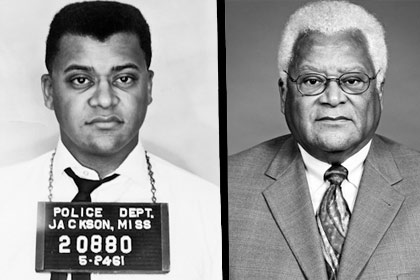
Mississippi Department of Archives and History; Eric Etheridge
Arrested after riding from Montgomery, Ala., to Jackson, Miss., on May 24, 1961; photographed Nov. 11, 2005, in Los Angeles
The Rev. James Lawson Jr.
In 1961. Lawson, a 32-year-old Methodist minister and divinity student, was already a veteran activist committed to nonviolence. He joined CORE in 1948 during his freshman year at Baldwin Wallace College in Berea, Ohio. A year later he withdrew his draft registration, which cost him 13 months in federal prison. In 1960 he was expelled from Vanderbilt University for his role as a leader of the Nashville, Tenn., sit-in movement.
In his words. "Our intention was that no matter how many people got beat up, we'd have another crew. If we got beat up in Jackson, we'd put another crew into Jackson who would go from Jackson to whatever the next stop was. That was the notion.
"But as the arrests took place in Jackson, and as we saw their effect, we decided to put out the cry and let people get arrested in Jackson and go after filling up the jails. That then became the strategy.
"We also realized we were going to put Jackson and Mississippi at center stage. Mississippi was a closed society. The Sovereignty Commission, the KKK, the White Citizens' Council were all very much in control."
Today. Lawson, 82, is pastor emeritus of Holman United Methodist Church in Los Angeles. In 1968, Martin Luther King Jr. came to Memphis at his request to speak to
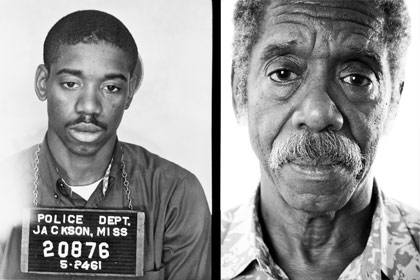
Mississippi Department of Archives and History; Eric Etheridge
Arrested after riding from Montgomery, Ala., to Jackson, Miss., on May 24, 1961; photographed May 25, 2007, in Nashville, Tenn.
Matthew Walker Jr.
In 1961. Walker was a 19-year-old sophomore at Fisk University in Nashville, Tenn. His father was the chairman of the surgery department at Meharry Medical College in Nashville.
In his words. "When we got to Mississippi, National Guardsmen boarded the bus with fixed bayonets on their rifles. They stood the length of the bus in the aisle. I said to one of them, 'Man, that's a mighty fancy rifle you've got there.'
"His response was, 'I ain't got one word to say to you.'
" 'Yeah,' I said to myself. 'These are our protectors.' "
Today. Walker, 69, returned to Nashville in the late 1990s after decades of work as an organizer. After dropping out of Columbia University in 1968, he coordinated rent strikes in Harlem and later worked as an organizer for the Commission for Racial Justice and the AFL-CIO.
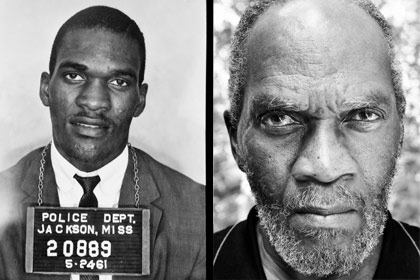
Mississippi Department of Archives and History; Eric Etheridge
Arrested after riding from Montgomery, Ala., to Jackson, Miss., on May 24, 1961; photographed May 9, 2007, in Atlanta
Frank Holloway
In 1961. Holloway, a 22-year-old student at Morehouse College in Atlanta and a leader of the Atlanta Student Moveent, had already been arrested several times for his role in sit-ins, picketing and other nonviolent protests.
In his words. "Nonviolence wasn't necessarily a way of life, but it was a tactic. We felt like it was a tactic that worked.
"I know for myself, I felt that this was what I was supposed to do. I didn't feel like I was a hero or anything like that. I just felt like this was what I was supposed to do. And I did it and when I stopped doing it, I didn't feel like anybody needed to reward me or congratulate me or pat me on my back. I did what I felt like I had to do."
Today. Holloway, 71, lives in his hometown of Atlanta. After working as a field secretary for SNCC from 1961 to 1967, he spent his career working for poverty and economic-action agencies.
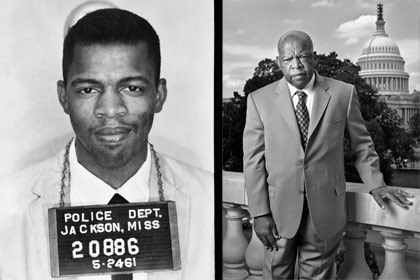
Mississippi Department of Archives and History; Eric Etheridge
Arrested after riding from Montgomery, Ala., to Jackson, Miss., on May 24, 1961; photographed July 25, 2007, in Washington, D.C.
U.S. Rep. John Lewis
In 1961. Lewis, a 21-year-old student at the American Baptist Theological Seminary in Nashville, Tenn., was a leader of the Nashville Student Movement and the 1960 sit-in campaign there. He volunteered to become one of the original 13 Freedom Riders.
In his words. "During our stay in Jackson and in Parchman [the Mississippi State Penitentiary was also known as Parchman Farm], there was this commitment, almost a bond, that we would do everything possible to get everyone to adhere to the philosophy and discipline of nonviolence. That we would not let anything break that.
"But the Freedom Rides not only took the movement off of college campuses and out of selected communities, it took it to a much larger community. The movement became much more inclusive. People saw these young Freedom Riders — and some not so young — getting on buses, traveling through the South, which was very dangerous. So people were willing and ready to become part of that effort."
Today. Lewis, 71, has represented Georgia's 5th Congressional District in the U.S. House of Representatives since 1987. From 1963 to 1966, Lewis served as the chairman of SNCC, which he'd helped to form, and by then he had already emerged as one of the key leaders of the civil rights movement. He was a keynote speaker at the historic March on Washington in 1963 and one of the leaders of the Selma March in 1965.
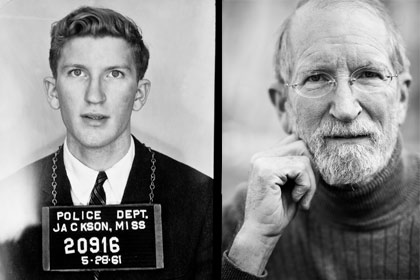
Mississippi Department of Archives and History; Eric Etheridge
Arrested after riding from Nashville, Tenn., to Montgomery, Ala., to Jackson, Miss., on May 28, 1961; photographed Nov. 18, 2006, in Cincinnati
David Fankhauser
In 1961. Fankhauser was a 19-year-old student at Central State University in Wilberforce, Ohio. He grew up in a family committed to nonviolent protest. His stepfather had been imprisoned several times for refusing the draft, and his family intentionally lived below the poverty line to avoid paying taxes that would support wars.
In his words. "I make no bones about it — I'm not a courageous person. Who do you get to go to war? You get the 19-year-olds. They don't have any idea of what they're getting into. 'Well, they're not really gonna kill me, are they?' That's not to say I wasn't scared. I was scared witless.
"Before I went to Jackson, I went home and shaved off my beard. My mom gave me a haircut. I know she was worried, but she was proud — just like the mothers are proud when their sons go off to war. They hope for the best, but they're proud of them doing what they see as a duty."
Today. Fankhauser, 69, is a professor of chemistry and biology at University of Cincinnati Clermont College in Batavia, Ohio, where he's taught since 1973.
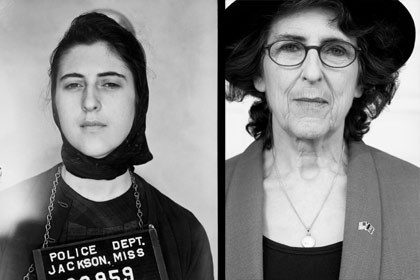
Mississippi Department of Archives and History; Eric Etheridge
Arrested after riding from Nashville, Tenn., to Jackson, Miss., on June 7, 1961; photographed Feb. 18, 2007, in San Francisco
Carol Silver
In 1961. Silver, 22, was living in New York and working at the United Nations, having graduated from the University of Chicago the previous year.
In her words. "The ride between Jackson and Parchman took about four hours and was more frightening than any previous part of the jail experience.
"The most terrifying part of the ride was the three times when the driver suddenly jolted off to the side of the highway and stopped. We imagined every horror, including an ambush by the KKK. I suppose they were just waiting for our escort of state police and FBI to catch up, or something equally innocent, but until we were moving again, none of us breathed an easy breath."
Today. Silver, 72, is a lawyer in private practice in San Francisco. She returned to the University of Chicago for law school, and from 1965 to 1970 returned each summer to Mississippi and Louisiana to work with the Lawyers Constitutional Defense Committee. She was elected to three terms on the San Francisco Board of Supervisors, serving from 1977 to 1989.
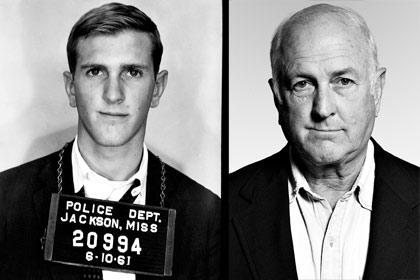
Mississippi Department of Archives and History; Eric Etheridge
Arrested after riding from Nashville, Tenn., to Jackson, Miss., on June 10, 1961; photographed May 14, 2005, in Berlin, Vt.
Stephen Green
In 1961. Green, 20, was a junior at Middlebury College in Middlebury, Vt.
In his words. "In Parchman, I was in a cell next to Stokely Carmichael. I was young and full of excitement about what was happening. The school year had just ended, and one day I said, 'All those college students are going to come to Mississippi!'
"From the next cell over, I hear Stokely say: 'Hear that, everybody? The white boys from Harvard and Yale are going to come save us!' "
Today. Green, 70, lives in Berlin, Vt. After graduating from Middlebury in 1962, he served two years in Niger in the Peace Corps. He went on to work extensively for the United Nations and its various agencies, including UNICEF and the World Food Program. He also worked as a journalist and served a term as a representative in the Vermont Legislature.
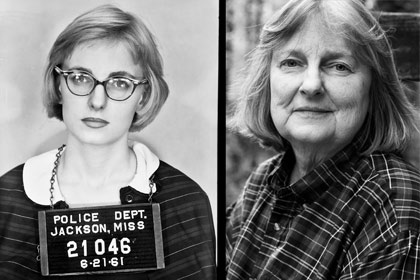
Mississippi Department of Archives and History; Eric Etheridge
Arrested after riding from Montgomery, Ala., to Jackson, Miss., on June 21, 1961; photographed May 3, 2007, in Tallahassee, Fla.
Margaret Leonard
In 1961. Leonard, an 18-year-old sophomore at Sophie Newcomb College in New Orleans, had participated in several CORE demonstrations there. Her parents were both newspaper reporters; her mother, who wrote a column for the Atlanta Journal, was known for her "integrationist" views.
In her words. "My mother was scared for me. So when I was in the Hinds County jail in Jackson, she called them up a lot to see how I was doing. She made it real funny, but she wanted them to know, 'We're watching to see how you're treating her.'
"Everybody called me Sissy. And she would call them up and say, 'Now Sissy likes scrambled eggs, she doesn't like fried eggs.' And the guy said, 'We don't have no scrambled eggs here.' "
Today. Leonard, 68, is retired and lives in Tallahassee, Fla. Following in her parents' footsteps, she spent most of her career as a newspaper reporter and editor, first at the Chattanooga Times and later for the St. Petersburg Times and other Florida newspapers.
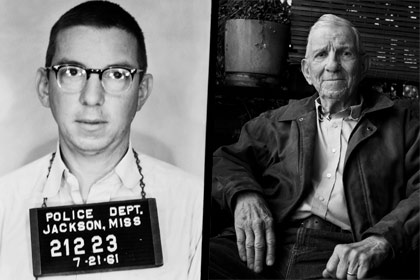
Mississippi Department of Archives and History; Eric Etheridge
Arrested at Hawkins Field Airport in Jackson, Miss., on July 21, 1961; photographed Feb. 16, 2007, in Berkeley, Calif.
Charles Sellers
In 1961. Sellers was a 37-year-old history professor at the University of California, Berkeley, where he'd been active in the local CORE chapter, challenging discrimination in stores, housing and other targets. He served three years in the Army during World War II and later earned degrees at Harvard University and the University of North Carolina at Chapel Hill.
In his words. "When I was in high school, I went to an NAACP meeting in a black church, which was packed with three or four hundred people. An imposing gentleman, who was introduced as Bishop Gordon of the AME Zion Church, got up and preached the most powerful sermon I had ever heard.
"I was one of only two or three white people in this enormous congregation, and I guess this was a 'scales falling from my eyes' kind of experience that I never got over. I was in dissent with my society from that time on."
Today. Sellers, 87, retired in 1990 and still lives in Berkeley. He is the author of The Market Revolution: Jacksonian America 1815-46 and a two-volume biography of James K. Polk.
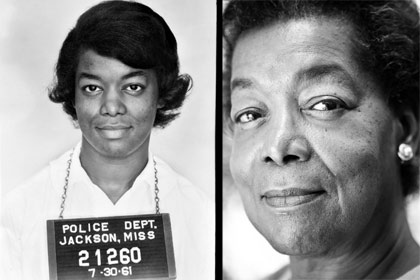
Mississippi Department of Archives and History; Eric Etheridge
Arrested at the Illinois Central Train Station after riding from New Orleans to Jackson, Miss., on July 30, 1961; photographed Aug. 19, 2005, in Los Angeles
Helen Singleton
In 1961. Singleton, a 28-year-old freshman at Santa Monica City College, became a Freedom Rider with her husband of six years, Robert Singleton.
In her words. "We went directly into the white waiting room and sat on the bench there. The policeman simply said, 'Are y'all going to move?' He asked us one more time, and we didn't. We were taken to the city jail. The person booking us was using what looked like an elementary school composition book.
"He said, 'What school do you go to?'
"I said, 'Santa Monica City College.'
"He said, 'How do you spell Santa Monica?'
"I was young at the time and thought he should have known how to spell."
Today. Singleton, 78, retired in 1999 and lives in Inglewood, Calif., with her husband. After transferring to UCLA and alternating college with child raising, Singleton graduated in 1974 with a fine arts major and went on to earn a master's degree in public administration from Loyola Marymount University. She developed programs in the arts and humanities for UCLA and worked as a consultant for arts groups.
